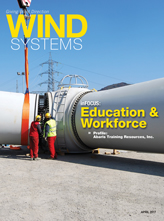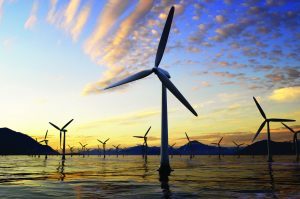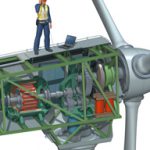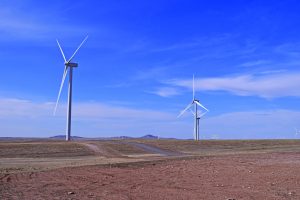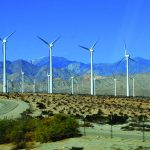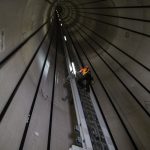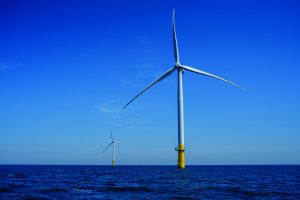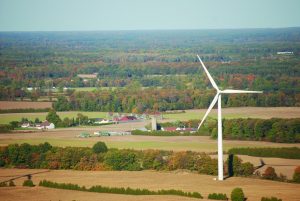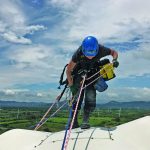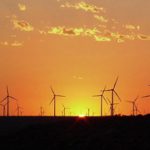The Department of Energy recently announced there are now more than 100,000 jobs in the wind industry.
That’s the good news.
The better news is that job-growth trend should continue as wind energy becomes an even bigger part of the power-generation picture.
“Right now, it’s as strong as it’s ever been,” said Suzanne Tegen, wind and waterpower deployment manager for the National Renewable Energy Laboratory (NREL). “The fastest growing job in the United States right now is the wind-power technician.”
But Tegen, whose work focuses on jobs, workforce, and economic analysis for distributed wind, utility-scale wind, hydropower, and other renewables, added that 25 to 30 percent of the wind workforce is in supply chain and manufacturing, and that also is showing an increase.

“That’s an area that’s growing, and those jobs are well-paying jobs both in cities and rural America,” Tegen said.
With most wind farms being installed in rural America, they can be a boon for farmers, ranchers, and others who lease their land for wind turbines.
“They’re receiving land-owner payments from developers and the local entities there,” Tegen said. “So the states and counties are receiving property taxes, which really benefit their schools and their roads and their local police and fire departments.”
Staying Strong
Wind and solar power — along with natural gas — have been at the top of energy growth in the U.S., and Tegen said NREL has been using different modeling techniques that show wind and solar are expected to stay strong.
“There have been a lot of scenarios that have come out of the Department of Energy where we have worked with industry to see what’s possible in the coming years,” Tegen said. “The Department of Energy’s wind-vision report shows that we could have 20 percent of the country’s electricity coming from wind by 2030, and 35 percent coming from wind by 2050. And if you look at wind growth today, we are actually exceeding the growth paths in those scenarios.”
And that growth is going to need workers that run a gamut of vocations.

Skills Assessment Report
In 2012, NREL did a skills assessment report for the wind industry, and Tegen said she is working on another one this year.
More than 350 employees from the wind industry were asked what kind of candidates they were looking for and if those candidates needed to have wind-specific education.
What NREL found was the industry needed engineers, according to Tegen. A function of those engineers is resource assessment.
“We need engineers who can look at the wind resource itself and look at the site,” she said. “Before the wind goes in, you have to take measurements for a year to two years and make sure you have a good, steady wind in that area. That’s wind-resource assessment or wind-resource characterization. So we need the people who can do that.”
Range of Workers
Workers also are needed in the manufacturing and supply chain. And researchers and scientists are necessary as well, according to Tegen.
“You have to do environmental surveys before you put in a wind farm,” she said.
In addition to the assessments and surveys, different types of scientists are needed to look at cultural resources. A lot of effort goes into community acceptance.
Regulatory workers come in on the governmental side. These workers look at policies and issue permits in local, state, and federal areas, and these are people who need to be informed about wind, according to Tegen. Along with regulatory workers, utility planners need to understand wind and how it can be integrated into a system.
“There are five states now that have more than 20 percent of electricity generated from wind energy,” Tegen said. “Ten years ago, we never would have guessed that. We would have thought that would have taken a lot of storage, which it doesn’t. We need electricity planners and utility employees who understand that.”
Growing Diversity

In addition to getting more workers into wind, part of the challenge is also making that workforce more diverse, although Tegen said that diversity is increasing.
During the 2012 workforce interviews, NREL found the workforce was about 20-21 percent women. The recent DOE survey showed that number had risen to 30 percent, although Tegen said the DOE might have looked at a different population than the one interviewed by NREL five years ago.
But when compared to the engineering programs across the country, which are typically about 17 percent women, 30 percent is promising, but Tegen said more can be done.
“We’re not trying to reflect current population,” she said. “We need to be more proactive about this. And so we’re looking at about 30 percent of the wind workforce. And a lot of those people are regulatory workers or attorneys and paralegals or administrative people. Not a lot of wind technicians are women. That’s a very, very small percentage.”
As far as other diversity, the DOE survey found about 25 percent were racial and ethnic minorities, according to Tegen. A lot of those jobs are in the trades and in the manufacturing and supply chain.
“We also looked at veterans, and that was about 10 percent,” she said. “And there are some proactive programs there to employ veterans out of service because they have very similar skills to what wind technicians would need.”
Looking at Europe
Europe’s wind workforce paints a different picture than the one in the U.S. Granted, Europe has been in the wind business a lot longer than the U.S., but an advantage it has is with its European Wind Energy Association and its focus on education.
“They make sure students have hands-on experience as well as academic experience, so you can actually get a master’s in wind energy and a Ph.D. in wind energy in Europe,” Tegen said. “Whereas here (in the U.S.) you go into a different discipline and then you maybe do your senior capstone project in wind energy or you do a week in one of your classes in renewable energy education.”
That’s one of the areas in the U.S. that needs to change, because companies that focus in wind want that wind knowledge right out of the gate, according to Tegen.
“They are hoping that those people do have hands-on experience as well as academic experience with renewable energy, and wind power is always a plus,” she said.
Training Challenge
The dilemma is that there aren’t a lot of training programs in the U.S. where engineers can get wind-energy education, according to Tegen.
There are some schools — James Madison University, UMass Amherst, Texas Tech — that do have programs like that,” she said. “In most of the typical engineering schools, you’ll have the engineers go into infrastructure, defense, or look at some of the more traditional energy sources. But the interest is growing, and we will see more renewable-energy programs for engineers.”
One caveat learned by NREL is students in college or graduate school may not see wind power as a career option.
“Maybe they haven’t heard of it, or maybe they don’t see it as a viable option, but there are well-paying jobs out there in wind energy,” Tegen said. “We need to do a better job in letting these students know that it’s a good career option where you can actually go out and make real money and have a job that makes a difference in the world.”
And that word needs to get out sooner rather than later, because wind is making strides in areas of the U.S. that, only a few short years ago, seemed untouchable.
Southeast U.S. Wind
“I just saw approval for the first wind farm in Virginia,” Tegen said. “And so we’re getting all the states onboard.”
It used to be, for the Southeast, the thought was that the wind wasn’t strong enough to support wind power. But that was when wind-turbine hub heights maxed out at 80 to 100 meters. With modern technology, hub heights will be 140 meters and higher. Those taller hub heights will have a positive impact on the wind potential in the Southeast.
“Certainly there’s wind-power manufacturing in the Southeast right now, but we also think that as we have more tall wind installed — so taller towers — we’re going to see more wind installations in the Southeast,” Tegen said.

Offshore Potential
And with the first offshore wind farm in operation off the coast of Rhode Island, the offshore wind industry is becoming another area that could take off.
“There could be a booming offshore wind workforce here,” Tegen said.
Port jobs and O&M jobs already exist at Block Island Wind Farm in Rhode Island, and Tegen said that, for the first few projects, some workers and equipment will be coming from overseas because offshore wind is still new to the U.S.
“Some equipment will be from overseas because we haven’t done this before, but certainly as we build these projects, you’ll see more of a workforce develop around the ports,” she said. “Besides the construction, manufacturing, and logistics, there will be long-term jobs in the maintenance of the wind farms.”
It will be an exciting learning curve for America’s wind industry, according to Tegen.
“The turbines that are offshore are a lot bigger,” she said. “And we don’t have experience yet with the turbine maintenance except with the Block Island project. It’ll be a great learning experience and a great opportunity for the United States workforce to be on the offshore side.”
And Tegen said for the West Coast, offshore wind will likely offer new and different challenges compared to the burgeoning East Coast wind industry.
“On the West Coast, we’re going to have to have floating offshore wind because the water is too deep right off the coast,” she said. “So we will probably have offshore wind farther off the coast, and that’s just a whole other learning opportunity for the port workers as well as the maintenance workers.”
Port jobs will become more viable because of the very nature of the massive parts.
“One of the things for offshore wind is that the blades and the towers are so large — they’re so much bigger than the land-based ones — that they need to be manufactured, so they can be shipped right to the offshore wind farms,” Tegen said. “They can’t go on highways. They’re too big. So there will be more local jobs for Americans who live near the coast.”
Made in the USA
One of the advantages of wind for the American worker is that a lot of wind-turbine equipment comes from the U.S., according to Tegen.
“And that’s true of wind and not necessarily true of other energy resources,” she said. “Most of the wind-turbine equipment comes from America. It’s made in America already.”
Part of what’s helped push the wind industry is the Production Tax Credit renewed last year by former President Barack Obama. But the PTC ends in 2020, so with that gone, it’s up to businesses and state governments to continue pushing for the clean energy that wind can supply, as well as the jobs the industry can create.
“I think the leadership from clean energy is coming from the states,” Tegen said. “We do see states that are developing or have renewable portfolio standards — or that don’t — that are looking to add wind energy because it’s one of the best economic options. States are encouraging clean energy, and some states are putting together a set-aside for offshore wind. They’re going to be pushing the envelope on creating these jobs, and these are brand-new jobs for American workers.”
















